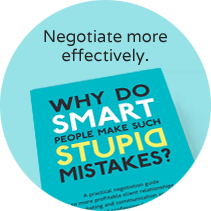Insights

Which is the luckiest agency?
P&G have reduced their 6000 agencies worldwide to 1250.
Whether P&G is a client of yours or not, it’s relevant to your agency. It indicates a ‘direction of travel’ – this is not a one-off. Similarly, Unilever went from 3000 agencies worldwide to 1500. It’s part of the cost cutting agenda, demanding, more for less, taking more in-house and overall squeezing agencies continually.
My agency clients are asking me how do we defend against this? What do we do to protect our margin from the constant pressure of ‘more for less’? Not surprisingly there is no simple answer. However part of the answer is about working smarter, not working harder. Too often I see agencies simply running faster, offering clients further discounts, working longer hours in the mistaken belief to show their clients just how ‘valuable’ the agency is! Working smarter is about finding time to think more strategically, helping your client be one step ahead of their competitors and adding real value to your client’s business.
Another part of the answer is to avoid being over-dependent on any one client. My recommendation is no client bigger than 10-12% of your business. I’ve written about this on many occasions so I won’t expand on this point for now.
Most weeks agencies bemoan the fact to me that they are increasingly dealing with mid-level and junior clients without any real decision making ability. These junior clients typically nit-pick and penny-pinch, often not understanding the bigger business picture their bosses can see. They often fail to understand your real value and business impact. Often in workshops I’m showing agencies how to target the csuite and senior decision makers and develop long term relationships. The danger is we are passed to who we sound like. Once we are passed ‘down’ we will find it very difficult, if not impossible, to get back in front of those senior clients who hold the purse strings, who understand value, are less price sensitive and are more focused on value, impact and results for their business.
If you are one of the agencies ‘lucky’ enough to remain working with P&G or Unilever I suspect for some of you the client will take the opportunity to emphasise to you just how lucky you are and they might want additional favours from you such as discounts, free hours, free ideas, longer payment terms……Sometimes we need to know when to walk away and say ‘thanks, but no thanks’. My concern is that under this kind of relationship you’ll find it hard to do our best work.
If you’re working at senior level with Unilever or P&G and are seen as a trusted partner then that’s brilliant – make sure you stay there and are charging top dollar for your work.
If you are one of the ‘discarded’ agencies then perhaps it’s an opportunity to stop and reflect about where your business is and where it should move for the future? How can you de-commoditise and differentiate your agency with a compelling and persuasive value proposition?
If you’re an agency not working with P&G or Unilever but working with other major corporates then maybe you need to ask yourself if your major client rationalises which agencies they will continue working with, which group will you fall into? What can you do to ensure you’re in the group of agencies you want to be in?
The best and most successful agencies aren’t lucky. They carefully choose which clients to work with and which to pitch for, have great peer to peer relationships with senior client decision makers and charge fees which take account of their value and impact, not just how much time they spent on the project.
Tagged in Negotiate| no comments
